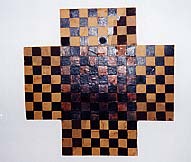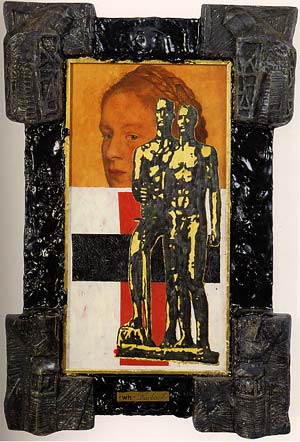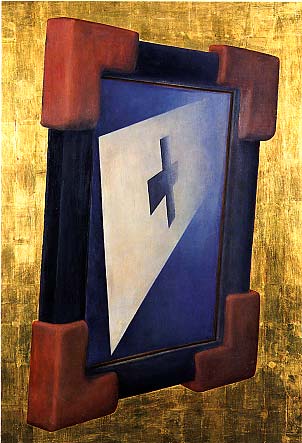NSK: Retro-Spection
In 1989, the same year that British artists were responding to Thatcherite Britain the art collective NSK-Neue Slowenische Kunst (New Slovene Art,) was formed in 1983 when the music and ideological group Laibach joined with the fine arts group Irwin and the theater group Red Pilot (later- Sester Scipion Nascine Theatre and most recently Noordung Cosmokinetic Theatre). Prior to the formation of NSK, Laibach also created its own visual artwork under the name of Laibachkunst. The only previous showings of Laibachkunst pieces were at the student cultural center in Belgrade (1981,) and SKU gallery in Ljubljana (1983). The 1983 exhibit was entitled Monumental Retro-Avant-Garde, referring to Laibach’s aesthetic strategy, which it continues to employ in current musical and cultural projects. Irwin, the chroniclers of time, has primarily taken over the production of fine arts within the collective. The Irwin pieces in the exhibit cover a fairly broad range of time (1984-1998) with images that have in large part developed out of the retro-avant-garde aesthetic of Laibachkunst. The Laibachkunst pieces generally represent the group’s work in the 1980s. The images were first created as posters announcing Laibach projects and concerts. In more recent years, these images have been reworked as paintings. Several examples of this were on site at the exhibition: Die Liebe ist die grösste Kraft, die alles schaft (1989-98), Die Liebe (1989-96), Die erste Bombardierung (1983-1998), Panorama, Decree (1987). In a reversal of Walter’s Benjamin’s discussion of the reproduction of art works, Laibach created paintings as reproductions of what were first silkscreen posters.
 The exhibit contained certain images that have become central to Laibach‘s aesthetic. The most exemplary work in this sense is Red Thrower (1981).
The exhibit contained certain images that have become central to Laibach‘s aesthetic. The most exemplary work in this sense is Red Thrower (1981).
Red Thrower contains some of Laibach‘s earliest and most consistent references to industrial society: the factory, the cog and wheel, and the worker with a raised hand, carrying a metal hammer. In the bottom left corner of the painting are a series of reproduced images of the Mona Lisa, similar to photo strips from an automatic photo booth. The photo strips articulate an awareness of the reproducibility of the image in the context of industrial and mechanical reproduction. The Mona Lisa‘s foreshadow the continual repetition of elements within Red Thrower, as well as the “classic” role of this image within Laibachkunst. The color red in Red Thrower suggests the then-contemporary political situation of Communism, and Yugoslavia’s “third way” of “Existing Socialism”. One of the early Laibach manifesto statements is “Art and Totalitarianism are not mutually exclusive,” suggesting the impossibility of separating art from politics and ideology.
 Kreuzschach (1971-1981) is a functional piece, an original that was used as a chessboard for four players.
Kreuzschach (1971-1981) is a functional piece, an original that was used as a chessboard for four players.
Similar to Marcel Duchamp’s artistic placement of a urinal in a gallery as a ready made, Kreuzschach is an every day object that now functions as a “piece of art” placed within institutional walls. This is the earliest piece in the collection, showing a reference to Kazimir Malevich’s Suprematist painting The Black Cross. It is important to recognize that Laibach never acknowledges Malevich as the inspiration for this piece. Similarly, Laibach does not clearly explain other references within the images or music it uses. The retro-avant-garde, as represented by Laibach, refers to a method of using past artwork and artistic styles as references and inspiration. This eclecticism is combined with a strict rejection of the concept of an original or individual author. Laibach is the only “author” of its work.
MB 84 Memorandum (1984) is another “classic” image within Laibach’s history. The image and its reproduction within Laibachkunst and other NSK groups emphasize a strategy of continual repetition, and the importance of context to meaning.
MB 84 Memorandum is an historically important piece as it served as a way to advertise Laibach‘s appearances when the name “Laibach” was banned in the early to mid 1980s. Due to a now-infamous television interview on Slovene TV, it was forbidden to print the name Laibach or to mention it on radio and television. The image was reproduced as posters and distributed to announce the performance and subvert the ban. That this image was recognized as a representation of Laibach shows the effectiveness of the group’s artistic strategies and the new contexts created from a new combination of older, pre-existing elements.
 Unlike Laibach, Irwin do attribute their own use of the Black Cross directly to Malevich. In Irwin’s Malevich Between Two Wars Malevich is even mentioned in the work’s title. During the panel discussion that occurred in connection with the exhibition NSK: Retro-Spection, a member of Irwin clearly stated that the group took the Black Cross from Malevich.
Unlike Laibach, Irwin do attribute their own use of the Black Cross directly to Malevich. In Irwin’s Malevich Between Two Wars Malevich is even mentioned in the work’s title. During the panel discussion that occurred in connection with the exhibition NSK: Retro-Spection, a member of Irwin clearly stated that the group took the Black Cross from Malevich.
 Irwin’s Left, Right, Up, Down (1994,) similarly incorporates Malevich’s Black Cross. Within this image, as in others, the references to Malevich coincide with references to Laibach‘s Black Cross. In line with retro-avant-garde strategy, Laibach succeeded in creating a new context from previously existent materials. The Black Cross has in fact come to represent Laibach as much as, if not more, than Malevich, particularly within the cultural scene of Slovenia during the 1980s and 90s.
Irwin’s Left, Right, Up, Down (1994,) similarly incorporates Malevich’s Black Cross. Within this image, as in others, the references to Malevich coincide with references to Laibach‘s Black Cross. In line with retro-avant-garde strategy, Laibach succeeded in creating a new context from previously existent materials. The Black Cross has in fact come to represent Laibach as much as, if not more, than Malevich, particularly within the cultural scene of Slovenia during the 1980s and 90s.
The Charleston exhibit, curated by Dr. Marian Mazzone of Charleston College, was comprised of a large portion of a private collection held by Mr. Neil Rector. Members of several NSK groups as well as the collector, Mr. Rector, were on hand for a number of events from May 20-27, 2001. The week-long activities provided an opportunity to better understand the NSK collective as a whole. There was a showing of Michael Benson’s film Predictions of Fire, a performance by the theater group Noordung, a reading by the Department of Pure and Applied Philosophy, as well as a reception and a panel discussion with various NSK members. The week of events coincided with the opening of Charleston’s annual Piccolo Spoleto arts festival.
The two floors of the exhibition space generally separated Laibachkunst (downstairs,) from Irwin images (upstairs,) except for a mixture of some of the most significant pieces along the main wall that greeted visitors upon entering the gallery. These first visible images provided an introduction to the work of different member groups of the collective (Irwin and Laibach,) while also emphasizing the distinct artistic developments within the collective since the mid 1980s and the late 1990s. While I can understand placing a mixture of Laibach and Irwin on one wall to be seen immediately upon entering, this manner of exhibiting the paintings did produce some confusion. It would have been more effective to organize Laibach’s pieces chronologically. A chronological presentation of the work would have enabled the foundational images of Laibachkunst to be recognized more easily. The subsequent reappearance and rearticulation of certain elements would have become more obvious, enabling the observer to better understand Laibach‘s strategies. However, in defense of the exhibition, it offered a sound representation of a wide variety of materials, as well as some pieces from the NSK graphic arts group New Collectivism– NK (Novi Kolektivizm). In combination with the surrounding events, (Noordung‘s performance, the Department of Pure and Applied Philosophy’s speech and the panel discussion) this was a very useful introduction to the collective’s work. It was a rare opportunity to experience the NSK collective as a whole, and to see first hand the specific works represented in the Retro-Spection exhibit, particularly within the United States.




